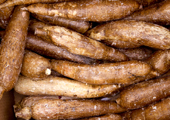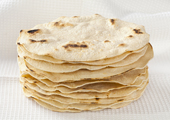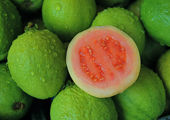Yuca
Not to be confused with yucca, a fruit-bearing shrub that has no relation whatsoever, yuca has a host of other names, including cassava and manioc. This starchy root, which can be white or yellow, must be cooked properly to detoxify and neutralize before eating. A wild version of this plant was first domesticated in Brazil more than10,000 years ago. A food staple for pre-Colombian people, it can even be seen in ancient works of art. When boiled, yuca is similar to potato in texture, and can be used in soups, stews and sauces. The dried root gives us tapioca.
Plantains
Simply put, plantains look a lot like bananas. Bearing fruit all year, they’re generally lower in sugar and firmer than "dessert" bananas, and are generally cooked or processed when green or overly ripe. Plantains are often treated like potatoes and are served as a side dish either boiled, fried or steamed.
Chipotle
Before it was a fast food chain, chipotle was (and still is) a smoke-dried jalapeño pepper. Chipotles are picked when they are bright red and have lost most of their moisture. Then they are brought to a smoking chamber, where they stay for several days. Chipotles add a deep, earthy spice to recipes. They can also be ground to make adobo, a meat marinade.
Tortillas
Meaning "little torta" or "little cake" in Spanish, the tortilla can refer to several foods in Spanish-speaking countries, ranging from a potato omelet in Spain to a corn or wheat flatbread eaten in Mexico and the United States. A familiar ingredient in tacos, burritos and enchiladas, tortillas can be fried or grilled, or cut into wedges and made into crunchy tortilla chips.
Jalapeño Peppers
Named after the Mexican town of Xalapa, the jalapeño is used in a variety of dishes where its heat lends a needed kick. Stuffed with cheese, deep-fried, smoked (see chipotle), pickled, made into jelly, even muddled and served in cocktails, jalapeños are usually picked while they are still a deep green color, but can sometimes ripen to a deep red and still retain flavor for use.
Beans
Originally a plant seed, the term "bean" can now refer to anything from a soybean to a chickpea to a black bean. Black beans are especially popular in Latin cuisine; their meaty texture makes them a natural for vegetarian dishes. Popular in burritos, soups, and feijoada, a pork, beef and bean stew and the national dish of Brazil, not to mention gallopinto, a rice and bean dish, in Costa Rica and Nicaragua, they’re also popular as a side dish with rice throughout the Latin food space.
Rice
One of the most important staple foods in the world, rice requires intensive labor and lots of water to grow. Rice is categorized as long, medium or short grained (medium-grained rice, for instance, is sticky, and often used in sushi); and is cooked by boiling or steaming. Introduced to Latin America by European colonizers, rice is often served as a side dish (often with beans) or even as the centerpiece of a meal, mixed with meat and vegetables, as in the Spanish paella.
Mango
Native to India, this juicy stone fruit is enjoyed around the world. The word mango, can also be used as a verb meaning “to pickle,” but the soft texture and sweet flavor of this word more often identified as a noun. A natural raw fruit snack, the mango is also used widely in chutneys, salads, and desserts, including smoothies and ice cream, as well as juice and sorbet.
Avocado
While several varieties of this green-skinned fruit exist, the Hass avocado, with its dark green pebbly skin and rich flavor, is the most popular. The fruit was introduced to the US from Mexico in the 19th century, but all Hass avocado trees, amazingly, are descended from one tree, raised by Rudolph Hass in the 1930s. The avocado is generally served raw in salads and sandwiches, and is most commonly used in guacamole. It has a high fat content, which makes it creamy and spreadable. Several cultures even enjoy avocados in desserts like shakes and ice cream.
Cilantro
Also known as coriander, this plant is entirely edible, though the fresh leaves and dried seeds are most commonly used parts of this herb. Most people have a strong reaction to cilantro, with some describing the flavor as “soapy” while others like adding cilantro to every plate. Heat diminishes the flavor of cilantro, so it is frequently used raw and the leaves are often added to guacamole and salsa. The dried fruit, known as coriander seed, is often used in curries to add a distinctive favor. Parsley makes an acceptable substitute for cilantro in a pinch.
Guava
Not as well-known as the mango, the scent of guava resembles that of a lemon, only it is not as sharp, and the taste has been described as being a hybrid of a pear and a strawberry.The color of the guava pulp ranges from white to deep red, and the flavor of the fruit can range from sweet to sour. In Mexico, the beverage agua fresca (a non-alcoholic drink) is often made with guava, while the juice extract can be used in sauces, candy and desserts. Guava can also be eaten raw, and its high level of pectin makes it useful for making jams and jellies.
Queso Fresco
The literal translation is "white cheese" and this creamy variety originated in Spain, but spread to Mexico and other countries as the Europeans moved west to the Americas. Queso fresco resembles farmer cheese or pot cheese in texture and consistency, and is often used to top Mexican dishes such as enchiladas. Perishable, queso fresco must be used immediately.






![Making Mealtime Matter with La Familia: Easy Sofrito [Video]](https://thelatinkitchen.com/wp-content/uploads/2015/10/sofrito-shutterstock__0-500x383.jpg)
![Easy Latin Smoothies: Goji Berry Smoothie [Video]](https://thelatinkitchen.com/wp-content/uploads/2015/12/goji_berry-shutterstock_-500x383.jpg)
















![Fun and Fast Recipes: Fiesta Cabbage Salad [Video]](https://thelatinkitchen.com/wp-content/uploads/2015/11/fiesta_cabbage_slaw-shutterstock_-500x383.jpg)









